Exercises (3202)
Extension and flexion of the arm while standing (right) ► triceps extension
Power
Individual work
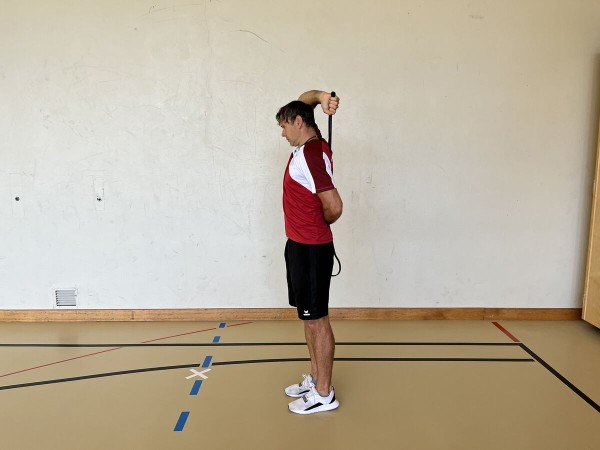

Stand upright, shoulder-width apart, one hand (left) holds the elastic band on the lower back, the other (right) arm is bent in a high position (elbow pointing diagonally upwards) and the hand holds the band on the back of the neck (the band is behind the body), stretch the upper (right) arm vertically upwards and bend back into the starting position without the elbow moving.
Attention:
Do not arch your back (tense your stomach), the movement takes place exclusively in the elbow joint (upper body and upper arm remain stable).
Lighten:
Choose an elastic band with less resistance.
Harden:
Choose an elastic band with greater resistance.
1 elasticated rubber band
Extension and flexion of the arm while standing (right) ► triceps extension
Power
Individual work
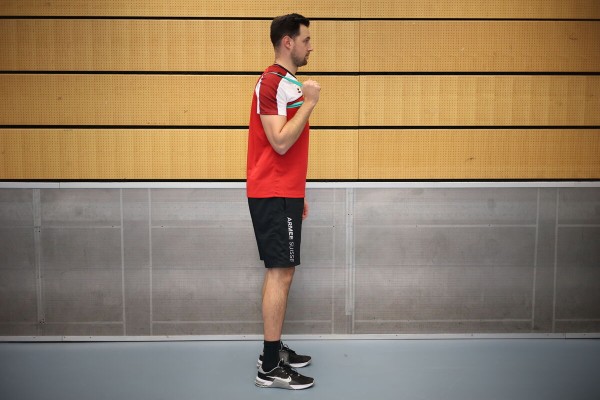
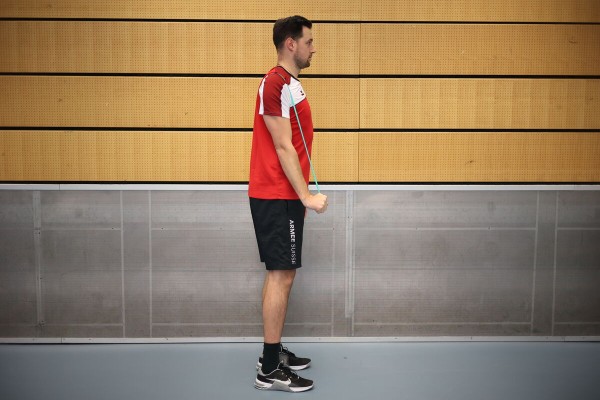
Standing upright with your arms shoulder-width apart, bend one arm (right) so that your hand is close to your shoulder (the back of your hand points away from your body), with your upper arm (elbow) pointing downwards and close to your body. With the hand of the bent training arm (right), grasp one end of the elasticated rubber band and place the other end around the shoulder (same side of the body). From this position, stretch the training arm (one-sided elbow extension) and bend back to the starting position.
Attention:
Do not arch your back (tense your stomach), the movement only takes place in the elbow joint (upper body and upper arm remain stable).
Lighten:
Choose a rubber band with less resistance.
Harden:
Choose a rubber band with greater resistance.
1 mini-band
Extension and flexion of the arm while standing (right) ► triceps extension
Power
Individual work


Stand upright shoulder-width apart, one arm (left) bent in front of the body (palm facing forwards, hand close to the shoulder on the same side of the body, elbow against the body), the other (right) training arm bent (approx. 90 degree angle in the elbow joint) behind the body (place the back of the hand in the centre of the back), grasp one end of the elasticated rubber band with each hand. From this position, stretch the training arm (right) (one-sided elbow extension) and bend back to the starting position.
Attention:
Do not arch your back (tense your stomach), the movement only takes place in the elbow joint (upper body and upper arm remain stable).
Lighten:
Choose a rubber band with less resistance.
Harden:
Choose a rubber band with greater resistance.
1 mini-band
Extension and flexion of the arm while standing (rowing pull) (left) ► row 1-arm
Power
Individual work
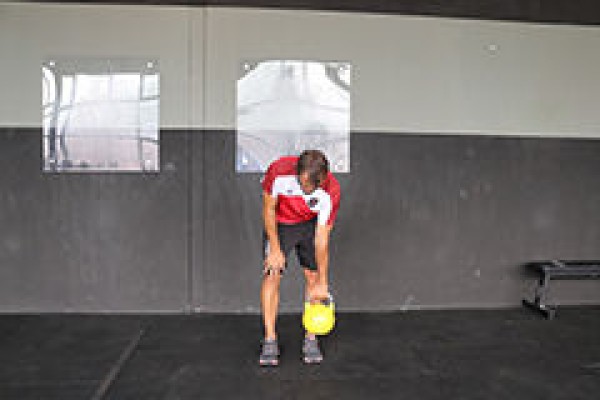
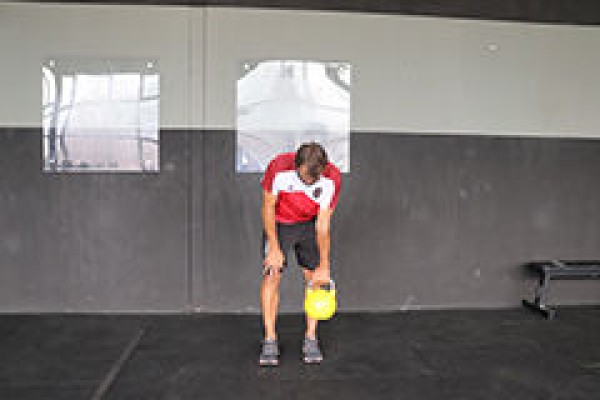
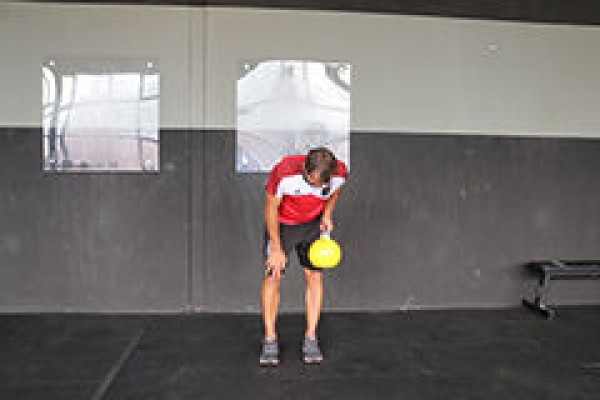


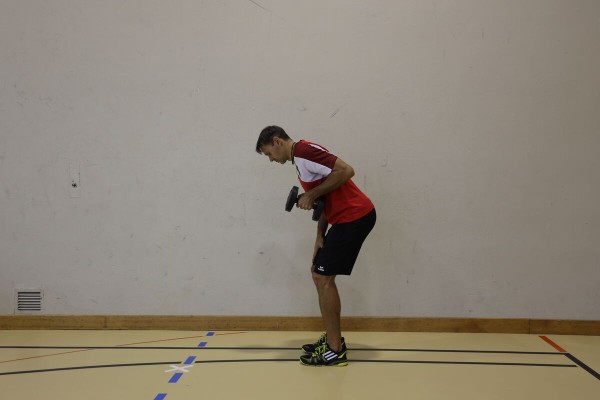
Standing shoulder-width apart, the upper body is tilted forwards with a straight back (or in a slight stepping position, with the leg on which the weight is held further back), the weight (kettlebell or dumbbell) is held in the hand slightly below knee height (same side of the body) with the (left) arm hanging down, the weight is gripped in the upper grip so that the back of the hand points forwards in the direction of vision. Raise the shoulder of the playing arm (left) with the arm extended before bending the arm to bring the weight to the chest (elbow close to the body pointing backwards). During the movement, the arm is rotated outwards (back of the hand points to the side away from the body). Then, in the reverse sequence of movements, stretch the arm back to the starting position (internal rotation).
Attention:
Always keep your back straight (tense your core). The angle of your back and thighs should remain the same throughout the exercise. Pull your elbows back and up (stay close to your body). The first impulse when lifting the weight always comes from the shoulder.
Lighten:
More weight.
Harden:
Less weight.
1 kettlebell/dumbbell
Extension and flexion of the arm while standing (rowing pull) (right) ► row 1-arm
Power
Individual work

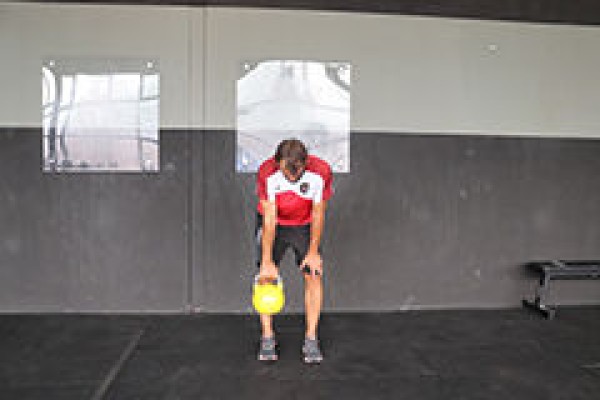
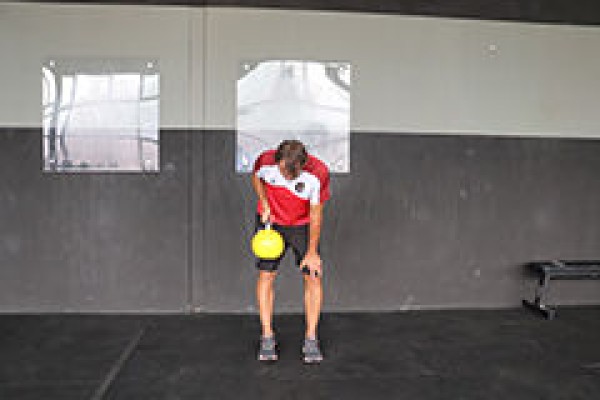
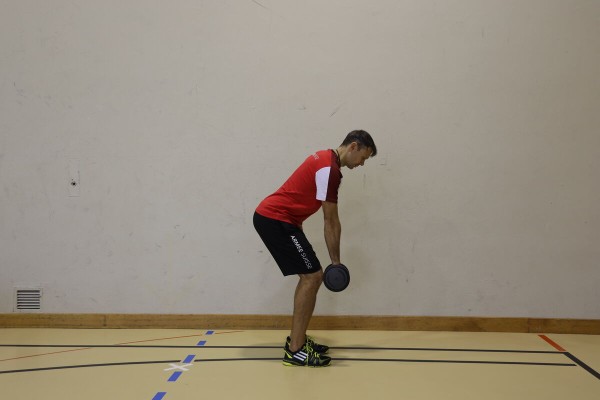
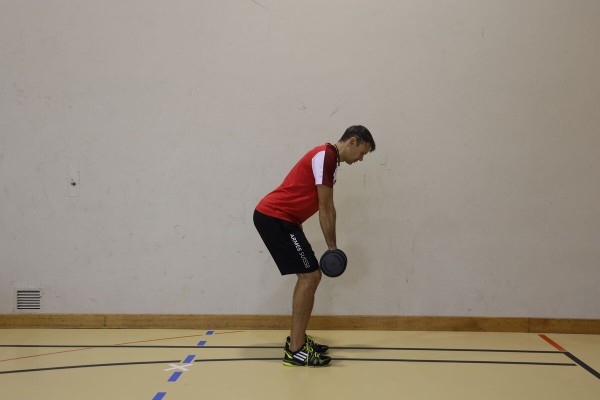

Standing shoulder-width apart, the upper body is tilted forwards with a straight back (or in a slight stepping position, with the leg on which the weight is held further back), the weight (kettlebell or dumbbell) is held in the hand slightly below knee height (same side of the body) with the (right) arm hanging down, the weight is gripped in the upper grip so that the back of the hand points forwards in the direction of vision. Raise the shoulder of the playing arm (right) with the arm extended before bending the arm to bring the weight to the chest (elbow close to the body pointing backwards). During the movement, the arm is rotated outwards (back of the hand points to the side away from the body). Then, in the reverse sequence of movements, stretch the arm back to the starting position (internal rotation).
Attention:
Always keep your back straight (tense your core). The angle of your back and thighs should remain the same throughout the exercise. Pull your elbows back and up (stay close to your body). The first impulse when lifting the weight always comes from the shoulder.
Lighten:
More weight.
Harden:
Less weight.
1 kettlebell/dumbbell
Extension and flexion of the arm while standing / raising the arm while standing (left) ► Shoulder press
Power
Individual work


Stand upright shoulder-width apart, one arm (left) bent in front of the body (palm facing forwards, hand close to the shoulder on the same side of the body, elbow against the body), the other (right) arm bent (approx. 90 degree angle at the elbow joint) behind the body (place the back of the hand in the centre of the back), grasp one end of the elasticated rubber band with each hand. From this position, stretch the training arm (left) upwards (one-sided shoulder press) to further stretch/tension the elastic band. Then bend your arm back to the starting position (bring your hand to your shoulder).
Attention:
Do not arch your back (tighten your stomach).
Lighten:
Choose an elastic band with less resistance.
Harden:
Choose an elastic band with more resistance.
1 mini-band
Extension and flexion of the arm while standing / raising the arm while standing (right) ► Shoulder press
Power
Individual work


Stand upright shoulder-width apart, one arm (right) bent in front of the body (palm facing forwards, hand close to the shoulder on the same side of the body, elbow against the body), the other (left) arm bent (approx. 90 degree angle at the elbow joint) behind the body (place the back of the hand in the centre of the back), grasp one end of the elasticated rubber band with each hand. From this position, stretch the training arm (right) upwards (one-sided shoulder press) to further stretch/tension the elastic band. Then bend your arm back to the starting position (bring your hand to your shoulder).
Attention:
Do not arch your back (tighten your stomach).
Lighten:
Choose an elastic band with less resistance.
Harden:
Choose an elastic band with more resistance.
1 mini-band
Extension and flexion of the arm in standing position with backward position (left) ► biceps curl
Power
Individual work
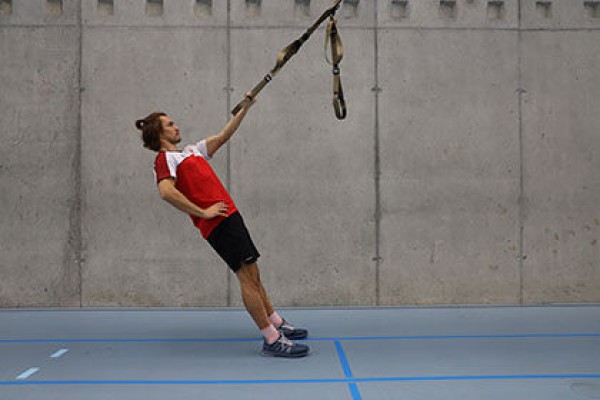
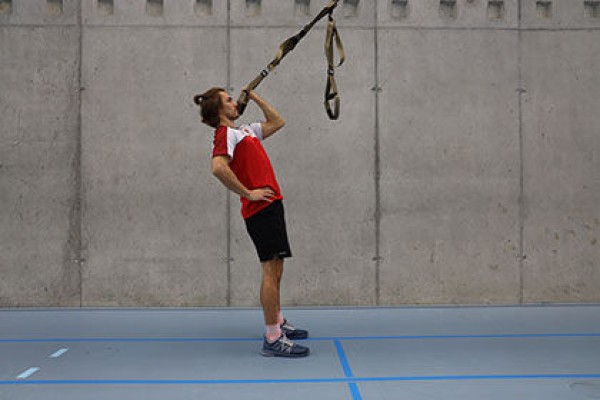
Set the sling trainer to a short length, stand upright and hold the handle with an outstretched (left) arm at shoulder height in front of your body, the sling is taut, take a step forwards (slightly backwards), pull your upper body towards the handle (bend and stretch your arm).
Attention:
Keep body tension, do not let hips sag, keep elbows in front of body.
Harden:
The more horizontal the starting position, the more challenging the exercise.
Variant:
The exercise can also be performed with both arms on the handles (organisation = 1 exercise).
1 sling trainer
Extension and flexion of the arm in standing position with backward position (right) ► biceps curl
Power
Individual work
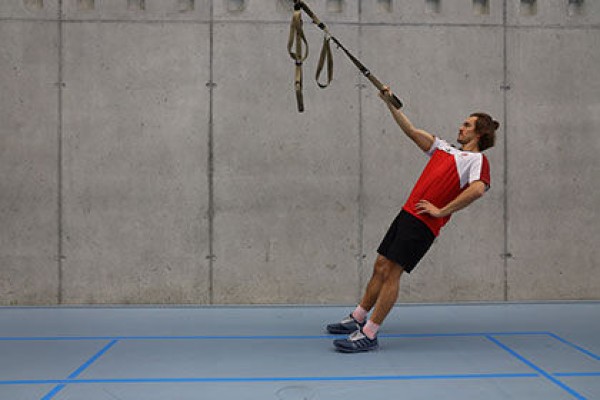
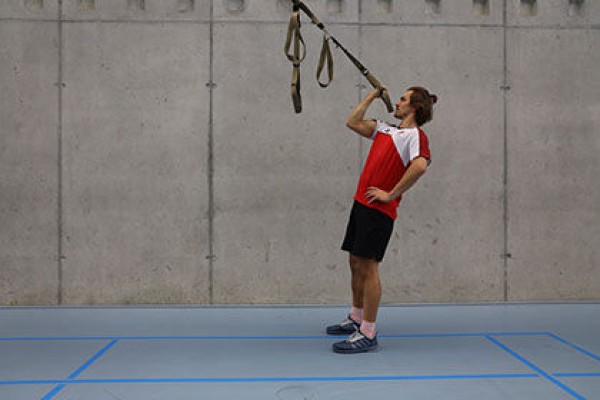
Set the sling trainer to a short length, stand upright and hold the handle with an outstretched (right) arm at shoulder height in front of your body, the sling is taut, take a step forwards (slightly backwards), pull your upper body towards the handle (bend and stretch your arm).
Attention:
Keep body tension, do not let hips sag, keep elbows in front of body.
Harden:
The more horizontal the starting position, the more challenging the exercise.
Variant:
The exercise can also be performed with both arms on the handles (organisation = 1 exercise).
1 sling trainer
Extension and flexion of the arm in a standing position with a forward presentation (left) ► triceps extension
Power
Individual work
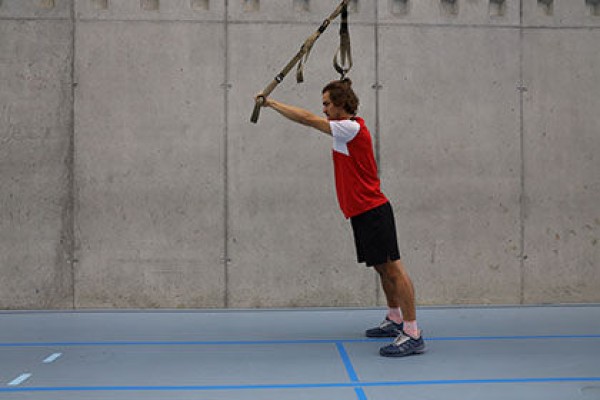
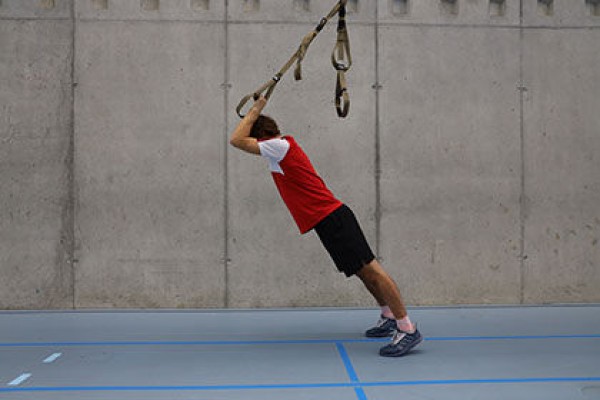
Set the sling trainer to a short length, stand upright (or in a walking position) with your back facing the attachment point, hold the handle with your (left) hand (upper grip) and lean slightly forwards (handle is above your head with your arm raised), stretch and bend your arm (raise and lower your upper body).
Attention:
The position of the elbow/upper arm remains stable (movement only from the elbow joint), maintain body tension, do not sag at the hips, no hollow back.
Harden:
The more horizontal the starting position, the more challenging the exercise.
Variant:
The exercise can also be performed with both arms on the handles (organisation = 1 exercise).
1 sling trainer
Extension and flexion of the arm in a standing position with forward presentation (right) ► triceps extension
Power
Individual work

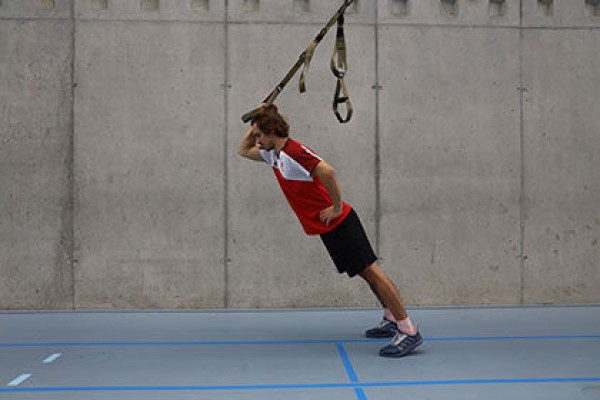
Set the sling trainer to a short length, stand upright (or in a walking position) with your back facing the attachment point, hold the handle with your (right) hand (upper grip) and lean slightly forwards (handle is above your head with your arm raised), stretch and bend your arm (raise and lower your upper body).
Attention:
The position of the elbow/upper arm remains stable (movement only from the elbow joint), maintain body tension, do not sag at the hips, no hollow back.
Harden:
The more horizontal the starting position, the more challenging the exercise.
Variant:
The exercise can also be performed with both arms on the handles (organisation = 1 exercise).
1 sling trainer
Extension and flexion of the arm in four-footed stance (left) ► triceps extension
Power
Individual work

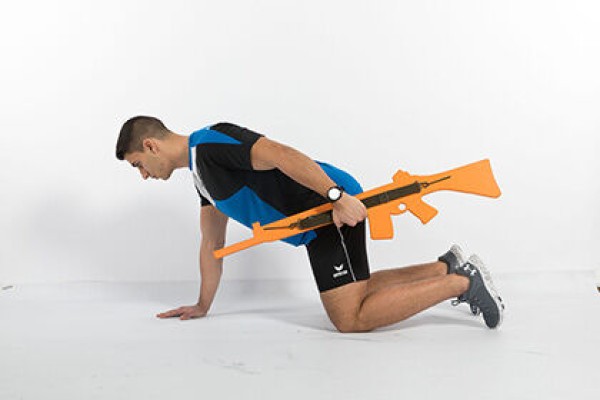
Four-foot stance, hold the weapon in one hand (left) on the hand guard parallel to the body (neutral grip) and raise the arm slightly (upper arm resting against the upper body, 90 degree angle in the elbow joint, barrel of the weapon pointing forwards in the direction of vision), extend the arm backwards into a horizontal position (barrel of the weapon pointing towards the ground) and bend back to the starting position.
Attention:
The movement is only performed from the elbow (upper arm remains stable against the body).
1 assault rifle (neutralised)
Extension and flexion of the arm in quadruped stance (right) ► triceps extension
Power
Individual work

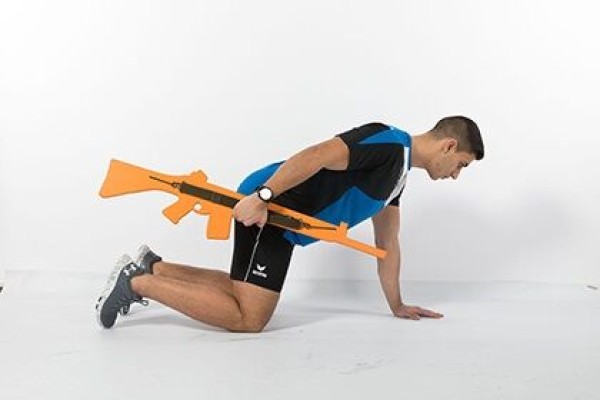
Four-foot stance, hold the weapon in one hand (right) on the hand guard parallel to the body (neutral grip) and raise the arm slightly (upper arm resting against the upper body, 90 degree angle in the elbow joint, barrel of the weapon pointing forwards in the direction of vision), extend the arm backwards into a horizontal position (barrel of the weapon pointing towards the ground) and bend back into the starting position.
Attention:
The movement is only performed from the elbow (upper arm remains stable against the body).
1 assault rifle (neutralised)
Extension and flexion of the arm in four-foot stance (rowing pull) (left) ► bird row 1-arm
Power
Individual work
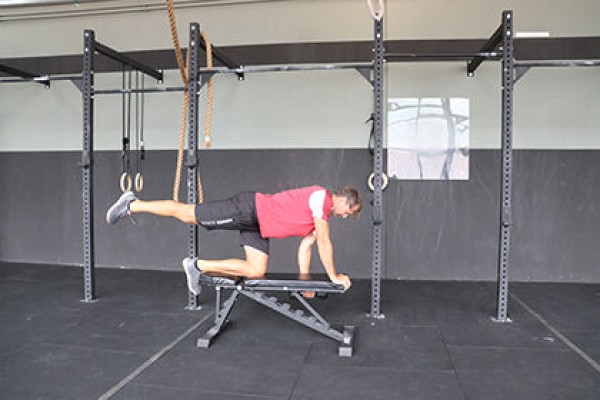
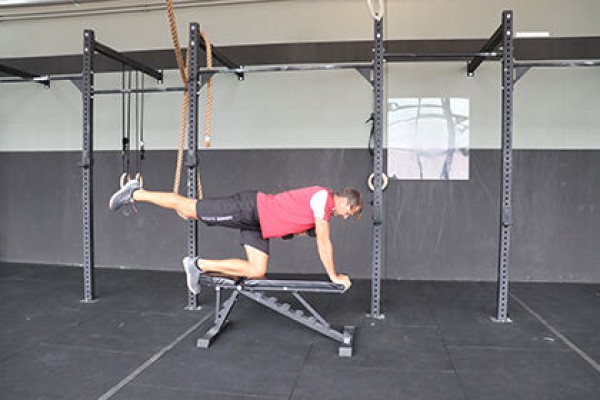
Four-foot stance, one leg (right) extended backwards in extension of the body, the arm on the same side of the extended leg supported on the (flat) bench, almost extended free training arm (left) holds the dumbbell/kettlebell and points towards the floor, bend the free arm (bring the elbow back up) to move the weight towards the abdomen and extend back to the starting position.
Starting position:
- Four-foot stance, one leg extended backwards in extension of the body
- Arm on the side of the extended leg supports the upper body on the bench
- Training arm almost extended points towards the floor
Finishing position:
- Training arm bent, pull dumbbell/kettlebell up to upper abdomen
- Move elbows as far back as possible
Harden:
Always make sure your back is straight (tense torso). The angle of your back and thighs should remain the same throughout the exercise. Pull your elbows back and up (stay close to your body).
1 flat bench
1 dumbbell/kettlebell
Extension and flexion of the arm in four-foot stance (rowing pull) (right) ► bird row 1-arm
Power
Individual work
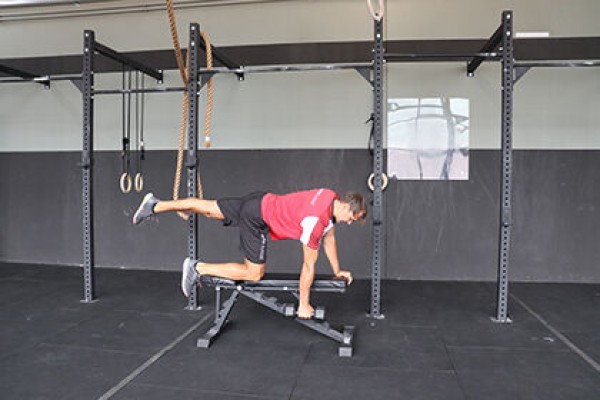
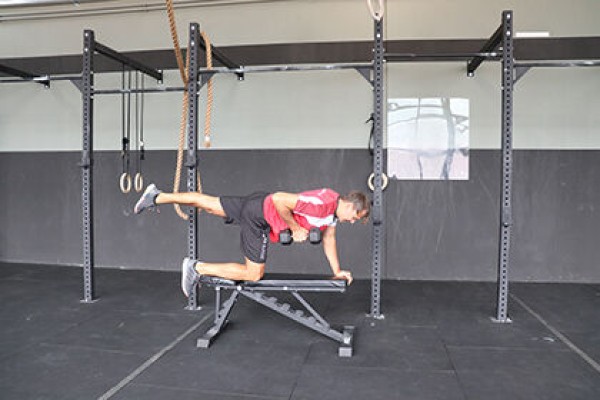
Four-foot stance, one leg (left) extended backwards in extension of the body, the arm on the same side of the extended leg supported on the (flat) bench, almost extended free training arm (right) holds the dumbbell/kettlebell and points towards the floor, bend the free arm (bring the elbow back up) to move the weight towards the abdomen and extend back to the starting position.
Starting position:
- Four-foot stance, one leg extended backwards in extension of the body
- Arm on the side of the extended leg supports the upper body on the bench
- Training arm almost extended points towards the floor
Finishing position:
- Training arm bent, pull dumbbell/kettlebell up to upper abdomen
- Move elbows as far back as possible
Attention:
Always make sure your back is straight (tense torso). The angle of your back and thighs should remain the same throughout the exercise. Pull your elbows back and up (stay close to your body).
1 flat bench
1 dumbbell/kettlebell
Extension and flexion of the arm in the standing balance (rowing pull) (left) ► row 1-arm/1-leg
Power
Individual work
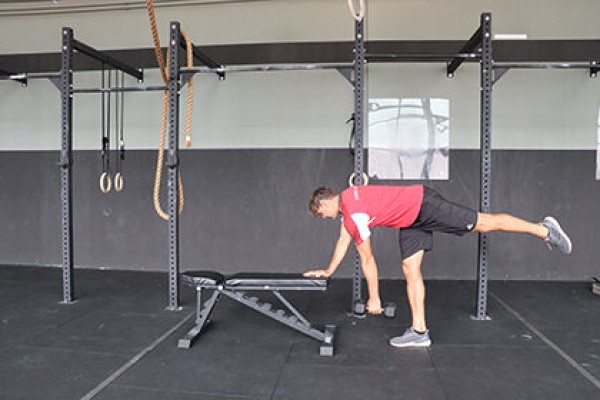
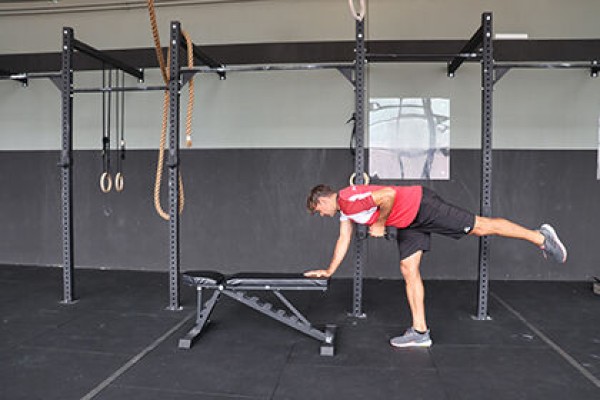
Standing balance, the hand (left) over the cross of the supporting leg (right) holds the dumbbell/kettlebell, to stabilise the balance the free hand can be supported on a (flat) bench, both arms are almost stretched out and point towards the floor, bend the training arm (elbow points backwards upwards) to move the weight towards the abdomen and stretch back to the starting position.
Starting position:
- Standing balance, knees of the supporting leg slightly bent
- Upper body leaning forwards, back straight, one leg stretched out behind in extension of the body
- Arms almost extended, pointing towards the floor
- Crossed arm of the supporting leg holds the dumbbell
- Free arm can be supported on a bench to help maintain balance
Finishing position:
- Training arm bent, pull dumbbell/kettlebell up to upper abdomen
- Move elbows as far back as possible
Attention:
Always make sure your back is straight (tense torso). The angle of your back and thighs should remain the same throughout the exercise. Pull your elbows back and up (stay close to your body).
Variant:
Playing arm and supporting leg correspond to the same side.
1 dumbbell/kettlebell
1 flat bench (optional)
Extension and flexion of the arm in the standing balance (rowing pull) (left) ► row 1-arm/1-leg
Power
Individual work

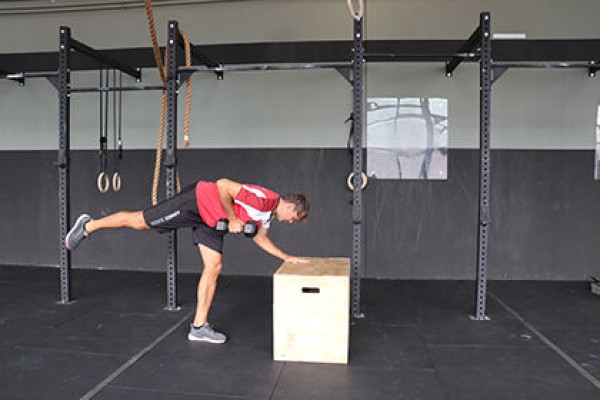
Standing balance, the hand (left) over the cross of the standing leg (right) holds the dumbbell/kettlebell, to stabilise the balance the free hand is supported on a swinging box, both arms are almost stretched out and point towards the floor, bend the training arm (elbow points backwards upwards) to move the weight towards the chest and stretch back to the starting position.
Attention:
Always make sure your back is straight (keep your core tensed). The angle of the back and thighs remains unchanged throughout the exercise. Pull your elbows back and up (stay close to your body).
Lighten:
Less weight.
Harden:
Without support (balance); more weight/increased load.
Variation:
Play arm and supporting leg on the same side.
1 vaulting box/plyo box
1 dumbbell/kettlebell
Extension and flexion of the arm in the standing balance (rowing pull) (left) ► row 1-arm/1-leg
Power
Individual work
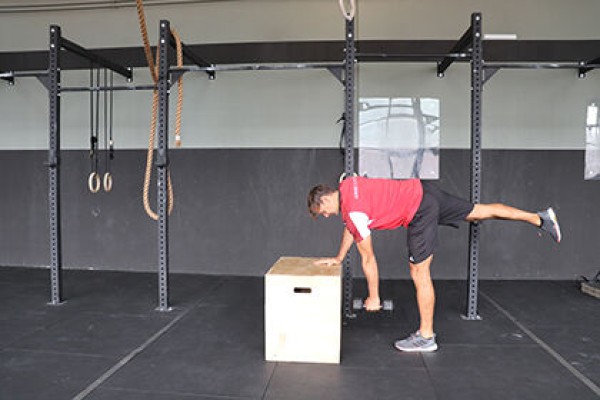
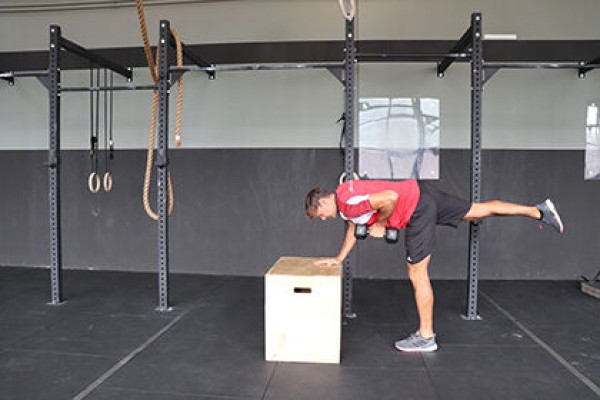
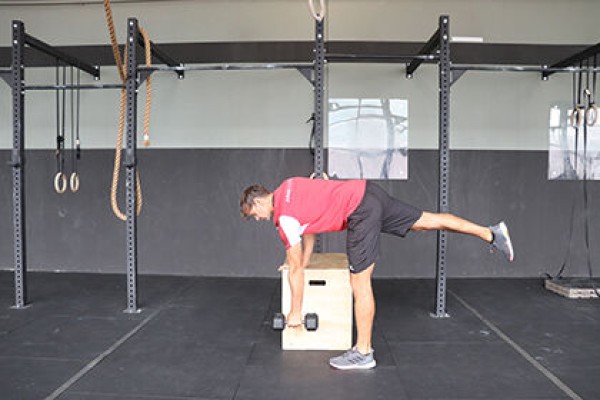
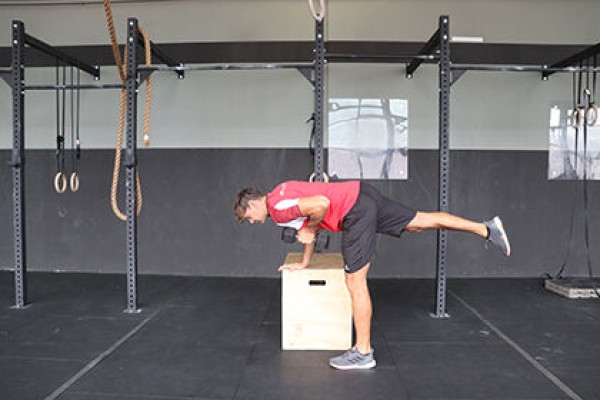
Standing balance, the hand (left) on the same side of the standing leg (left) holds the dumbbell/kettlebell, to stabilise the balance the free hand is supported on a swinging box, both arms are almost stretched out and point towards the floor, bend the training arm (elbow points backwards upwards) to move the weight towards the chest and stretch back to the starting position.
Attention:
Always make sure your back is straight (keep your core tensed). The angle of the back and thighs remains unchanged throughout the exercise. Pull your elbows back and up (stay close to your body).
Lighten:
Less weight.
Harden:
Without support (balance); more weight/increased load.
Variant:
Play arm with weight in hand and supporting leg crossed.
1 Swedish box/pyo box
1 dumbbell/kettlebell
Extension and flexion of the arm in the standing balance (rowing pull) (left) ► row 1-arm/1-leg
Power
Individual work
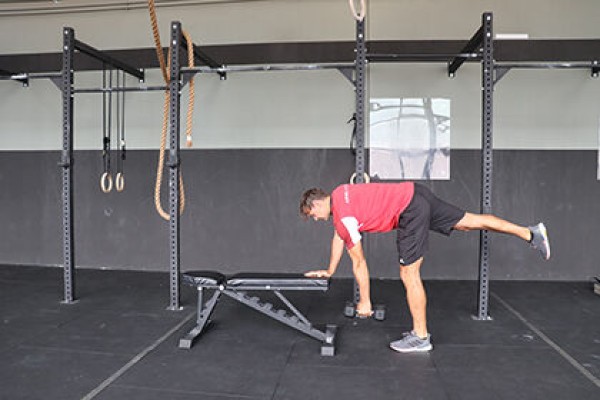
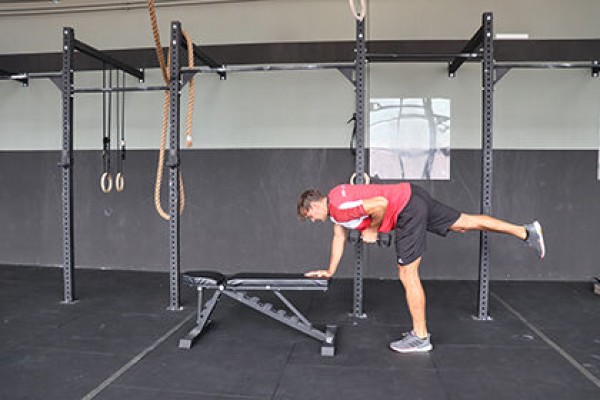
Standing balance, the hand (left) on the same side of the body as the standing leg (left) holds the dumbbell/kettlebell, to stabilise the balance the free hand can be supported on a (flat) bench, both arms are almost stretched out and point towards the floor, bend the training arm (elbow points backwards upwards) to move the weight towards the abdomen and stretch back to the starting position.
Starting position:
- Standing balance, knees of the supporting leg slightly bent
- Upper body tilted forwards, back straight, one leg stretched out behind in extension of the body
- Arms are almost straight, pointing towards the floor
- Arm on the same side of the supporting leg holds the dumbbell
- Free arm can be supported on a bench to help maintain balance
Finishing position:
- Training arm bent, pull dumbbell/kettlebell up to the upper abdomen
- Move elbows as far back as possible
Attention:
Always make sure your back is straight (tense torso). The angle of your back and thighs should remain the same throughout the exercise. Pull your elbows back and up (stay close to your body).
Variant:
Cross your playing arm and supporting leg.
1 dumbbell/kettlebell
1 flat bench (optional)
Extension and flexion of the arm in the standing balance (rowing pull) (right) ► row 1-arm/1-leg
Power
Individual work


Standing balance, the hand (right) over the cross of the supporting leg (left) holds the dumbbell/kettlebell, to stabilise the balance the free hand can be supported on a (flat) bench, both arms are almost stretched out and point towards the floor, bend the training arm (elbow points backwards upwards) to move the weight towards the abdomen and stretch back to the starting position.
Starting position:
- Standing balance, knees of the supporting leg slightly bent
- Upper body leaning forwards, back straight, one leg stretched out behind in extension of the body
- Arms are almost straight, pointing towards the floor
- Crossed arm of the supporting leg holds the dumbbell
- Free arm can be supported on a bench to help maintain balance
Finishing position:
- Training arm bent, pull dumbbell/kettlebell up to upper abdomen
- Move elbows as far back as possible
Attention:
Always make sure your back is straight (tense torso). The angle of your back and thighs should remain the same throughout the exercise. Pull your elbows back and up (stay close to your body).
Variant:
Playing arm and supporting leg correspond to the same side.
1 dumbbell/kettlebell
1 flat bench (optional)
Extension and flexion of the arm in the standing balance (rowing pull) (right) ► row 1-arm/1-leg
Power
Individual work
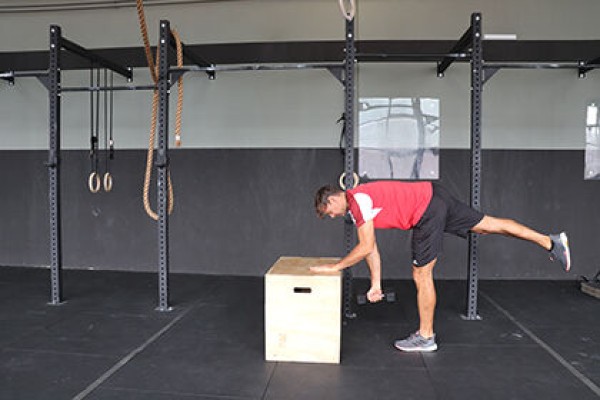
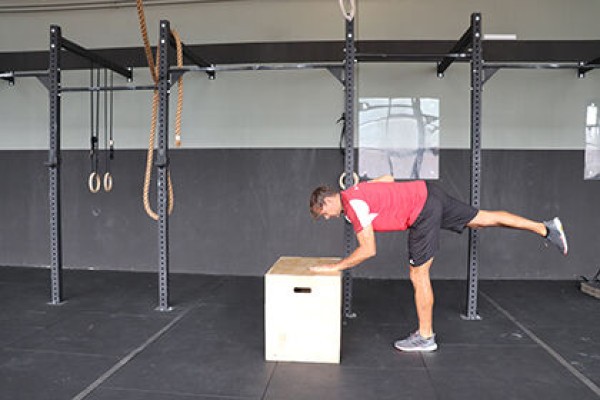
Standing balance, the hand (right) over the cross of the standing leg (left) holds the dumbbell/kettlebell, to stabilise the balance the free hand is supported on a swinging box, both arms are almost stretched out and point towards the floor, bend the training arm (elbow points backwards upwards) to move the weight towards the chest and stretch back to the starting position.
Attention:
Always make sure your back is straight (keep your core tensed). The angle of the back and thighs remains unchanged throughout the exercise. Pull your elbows back and up (stay close to your body).
Lighten:
Less weight.
Harden:
Without support (balance); more weight/increased load.
Variation:
Play arm and supporting leg on the same side.
1 vaulting box/plyo box
1 dumbbell/kettlebell
Extension and flexion of the arm in the standing balance (rowing pull) (right) ► row 1-arm/1-leg
Power
Individual work
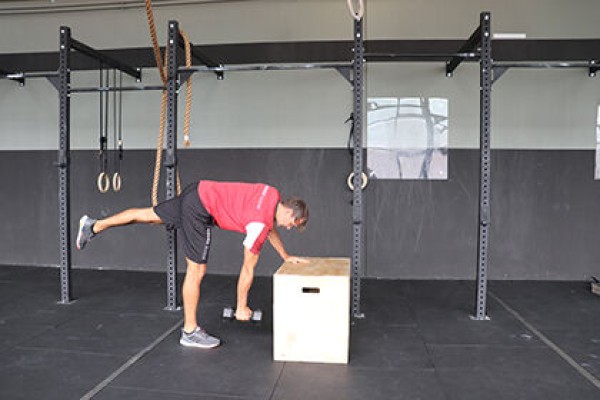

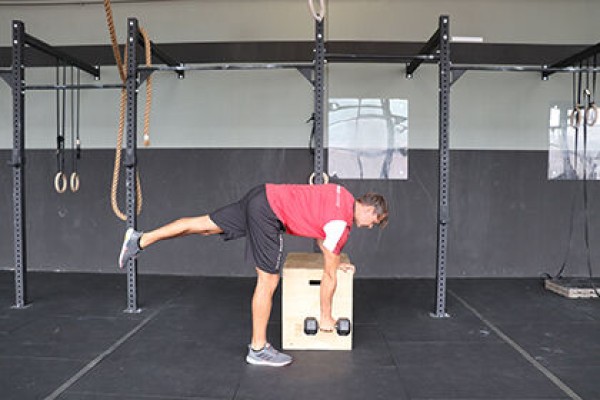
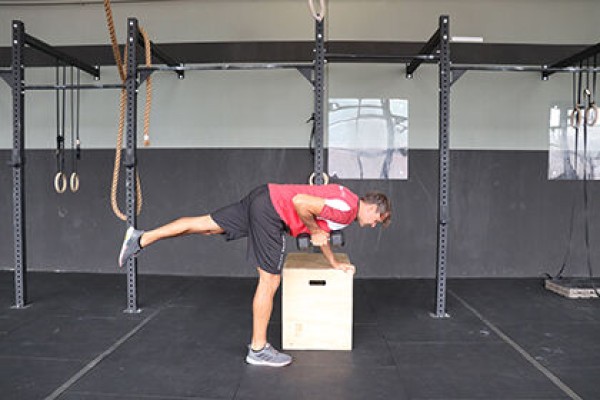
Standing balance, the hand (right) on the same side of the standing leg (right) holds the dumbbell/kettlebell, to stabilise the balance the free hand is supported on a swinging box, both arms are almost stretched out and point towards the floor, bend the training arm (elbow points backwards upwards) to move the weight towards the chest and stretch back to the starting position.
Attention:
Always make sure your back is straight (keep your core tensed). The angle of the back and thighs remains unchanged throughout the exercise. Pull your elbows back and up (stay close to your body).
Lighten:
Less weight.
Harden:
Without support (balance); more weight/increased load.
Variant:
Play arm with weight in hand and supporting leg crossed.
1 vaulting box/plyo box
1 dumbbell/kettlebell
Extension and flexion of the arm in the standing balance (rowing pull) (right) ► row 1-arm/1-leg
Power
Individual work
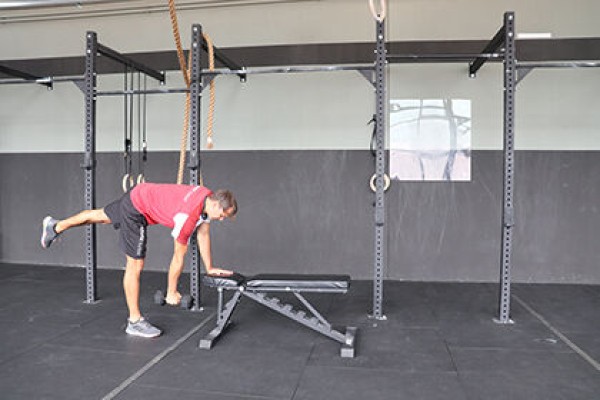
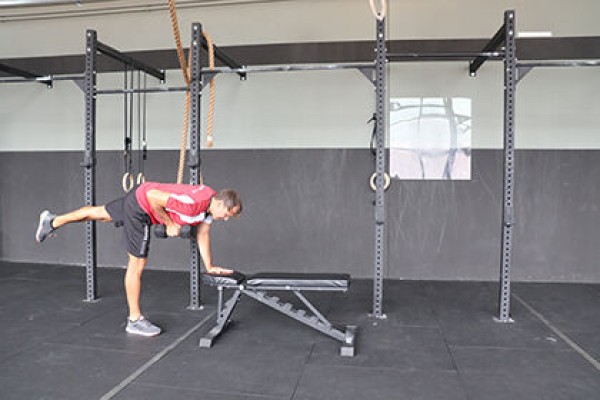
Standing balance, the hand (right) on the same side of the body as the standing leg (right) holds the dumbbell/kettlebell, to stabilise the balance the free hand can be supported on a (flat) bench, both arms are almost stretched out and point towards the floor, bend the training arm (elbow points backwards upwards) to move the weight towards the abdomen and stretch back to the starting position.
Starting position:
- Standing balance, knees of the supporting leg slightly bent
- Upper body tilted forwards, back straight, one leg stretched out behind in extension of the body
- Arms are almost straight, pointing towards the floor
- Arm on the same side of the supporting leg holds the dumbbell
- Free arm can be supported on a bench to help maintain balance
Finishing position:
- Training arm bent, pull dumbbell/kettlebell up to the upper abdomen
- Move elbows as far back as possible
Attention:
Always make sure your back is straight (tense torso). The angle of your back and thighs should remain the same throughout the exercise. Pull your elbows back and up (stay close to your body).
Variant:
Cross your playing arm and supporting leg.
1 dumbbell/kettlebell
1 flat bench (optional)
Extension and flexion of the arm in a kneeling position with the upper body supported (left) ► triceps extension
Power
Individual work
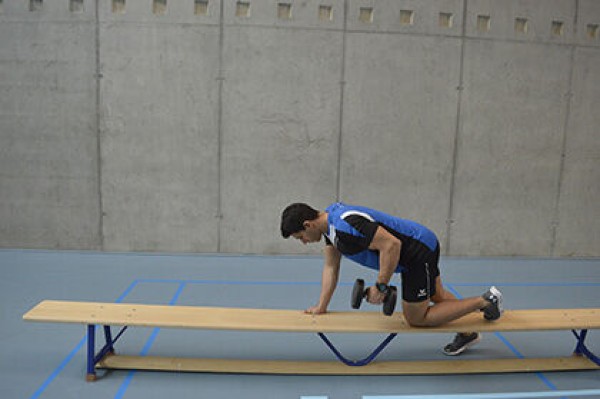

One-legged stand on the right, other leg (left) kneeling on the long bench (knee height of standing leg), one-armed support of the upper body on the long bench (supporting arm on the side of the standing leg), free arm (left) with the dumbbell in the hand close to the body stretched backwards in extension of the body, bend arm/elbow (approx. 90 degrees in the elbow joint) and stretch back to the starting position (raise weight). 90 degrees at the elbow joint) and stretch back to the starting position (lift and lower the weight).
Attention:
Upper arm remains fixed (movement only at the elbow joint), straight back.
Lighten:
Less weight.
Harden:
More weight.
1 long bench
1 dumbbell
Extension and flexion of the arm in a kneeling position with the upper body supported (left) ► triceps extension
Power
Individual work
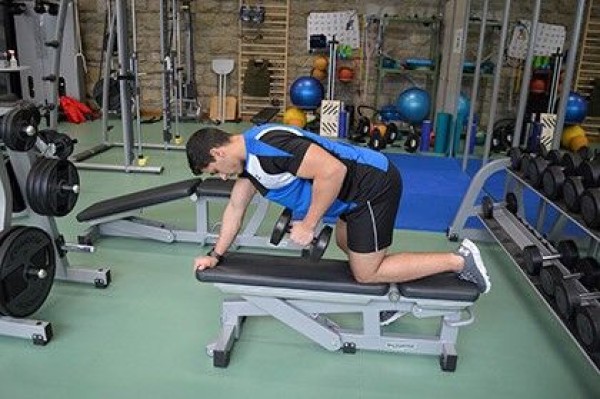

The body is supported with one knee and one arm on the flat bench (same side of the body, right). The other (left) foot is placed on the floor and the dumbbell is held in a neutral grip with the free (left) arm. The training arm is bent (approx. 90 degrees) so that the upper arm rests against the body (horizontal) and the lower arm points towards the floor (vertical). The arm is now stretched to bring the forearm into a horizontal position. The rest of the body remains still. Then bend the arm back to the starting position.
Starting position:
- Body is supported with one knee and one arm on the flat bench (same side of the body)
- Dumbbell in neutral grip
- Upper arm of the training arm is parallel to the back against the body
- Lower arm of the training arm points towards the floor (right angle in the elbow joint)
Finishing position:
- Training arm is parallel to the floor (stretched)
- Wrist remains stable
- Rest of body remains unchanged in the starting position.
Attention:
The movement (bringing the forearm into a horizontal position) is only performed from the elbow joint.
1 flat bench
1 dumbbell